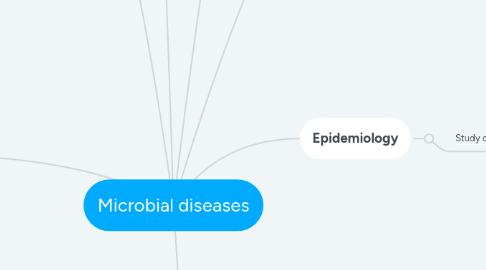
1. Spread of infection
1.1. Reservoirs
1.1.1. Human reservoirs
1.1.1.1. People without exhibiting any signs of illness but can harbour pathogens and transmit them to others — carriers
1.1.1.1.1. Eg : AIDS, diphtheria, typhoid fever, hepatitis, gonorrhea
1.1.2. Animal reservoirs
1.1.2.1. Zoonoses - wild & domestic animals that transmitted diseases to humans
1.1.2.1.1. Eg : Rabies found in bats, skunks, foxes, dogs, cats. Lyme disease found in field mice.
1.1.3. Nonliving reservoirs
1.1.3.1. Soil
1.1.3.1.1. Eg : fungi which cause mycoses including ringworm and systemic infections, Clostridium botulinum which causes bumotulism
1.1.3.2. Water
1.1.3.2.1. Eg: Vibrio cholerae which causes cholera, Salmonella typhi which causes typhoid fever
1.1.3.3. Improperly prepared or stored food
2. Human microbiome
2.1. Normal microbiota
2.1.1. Benefits the host by preventing the overgrowth of harmful microorganisms — microbial antagonism
2.1.1.1. Relationship between the normal microbiota & host — symbiosis
2.1.1.1.1. Commensalism
2.1.1.1.2. Mutualism
2.1.1.1.3. Parasitism
2.2. Transient microbiota
3. Koch’s postulates
3.1. Provide framework for the study of the etiology of any infectious disease.
3.2. Limitations : some organisms cannot be grown in laboratory medium, infected individuals do not always have clear-cut symptoms, some diseases are polymicrobial, suitable hosts not always available for testing.
3.3. Criteria : same pathogen must be present in every case of the disease, pathogen must be isolated from the diseased host and grown in pure culture, same disease must be produce when pure culture is introduced into susceptible laboratory animal, pathogens must be recovered from experimentally infected hosts.
4. Classifying infectious disease
4.1. Identification
4.1.1. Symptoms
4.1.2. Signs
4.1.3. Syndrome
4.2. Disease behaviour
4.2.1. Communicable disease
4.2.2. Non-communicable disease
4.3. Occurrence of a disease
4.3.1. Reported by
4.3.1.1. Incidence of a disease
4.3.1.2. Prevalence of a disease
4.3.2. Frequency of occurrence
4.3.2.1. Sporadic
4.3.2.2. Endemic
4.3.2.3. Epidemic
4.3.2.4. Pandemic
4.4. Severity of a disease
4.4.1. Acute disease
4.4.2. Chronic disease
4.4.3. Subacute disease
4.4.4. Latent disease
4.5. Extent of host involvement
4.5.1. Local infection
4.5.2. Systemic infection
4.5.3. Primary infection
4.5.4. Secondary infection
4.5.4.1. Caused by opportunistic pathogen
5. Epidemiology
5.1. Study of the transmission, incidence, and frequency of disease.
5.1.1. How microorganisms enter a host?
5.1.1.1. Portals of entry
5.1.1.1.1. Mucous membrane
5.1.1.1.2. Skin
5.1.1.1.3. The parenteral route
5.1.1.2. Numbers of invading microbes
5.1.1.2.1. LD50 (lethal dose for 50% of the inoculated hosts)
5.1.1.2.2. ID50 (infectious dose for 50% of the inoculated hosts)
5.1.1.3. Adherence
5.1.1.3.1. Adhesins or ligands
5.1.1.3.2. Biofilms
5.1.2. How bacterial pathogens penetrate host defences?
5.1.2.1. Capsules
5.1.2.1.1. Resists the host’a defences by impairing phagocytosis.
5.1.2.2. Cell wall components
5.1.2.2.1. Contain chemical substances that contribute to virulence. Eg : Streptococcus pyogenes produced a heat-resistant and acid-resistant protein called M protein..
5.1.2.3. Antigenic variation
5.1.2.3.1. Some pathogens can alter their surface antigens, thus avoiding the host‘a antibodies.
5.1.2.4. Enzymes
5.1.2.4.1. Coagulases — bacterial enzymes that coagulate the fibrinogen in blood and converted into fibrin.
5.1.2.4.2. Kinases — bacterial enzymes that break down fibrin and thus dissolve clots formed by the body to isolate the infection.
5.1.2.4.3. Hyaluronidase — enzymes secreted by certain bacteria to hydrolyse hyaluronic acid, a type of polysaccharide that holds together certain cells of the body.
5.1.2.4.4. Collagenase — breaks down the protein collagen, which forms the connective tissue of muscles and other body organs and tissues.
5.1.2.4.5. IgA proteases — destroy IgA antibodies produced by the host as a defence against adherence of pathogens to mucosal surfaces.
5.1.2.5. Penetration into the host
5.1.3. How bacterial pathogens damage host cells?
5.1.3.1. Using the host’s nutrients
5.1.3.2. Direct damage
5.1.3.3. The production of toxins
5.1.3.3.1. Membrane-disrupting toxins / type II toxins
5.1.3.3.2. Superantigens / type I toxins
5.1.3.3.3. Endotoxins
5.1.3.4. Plasmids, lysogeny, pathogenicity
5.1.3.4.1. Lysogenic conversion
6. Transmission of disease
6.1. Contact transmission
6.1.1. Indirect contact transmission
6.1.2. Direct contact transmission
6.1.3. Droplet transmission
6.2. Vehicle transmission
6.2.1. Waterborne
6.2.2. Airborne
6.2.3. Foodborne
6.3. Vectors
6.3.1. Mechanical transmission
6.3.2. Biological transmission

